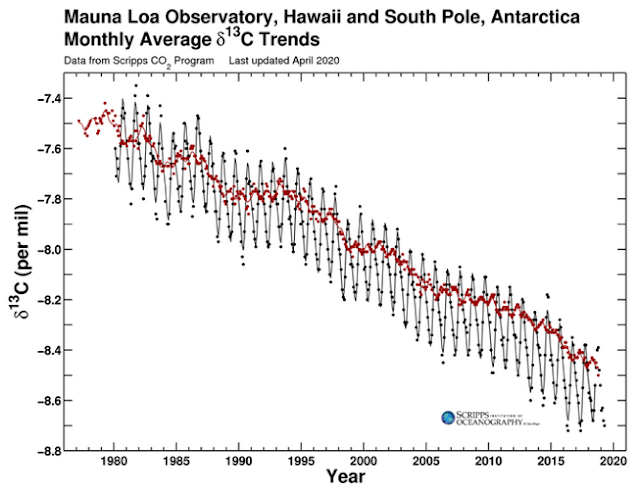Can Geothermal Heat or Volcanoes Explain Current Warming?
 |
| Map of Geothermal Heat Flux from Davies 2010 |
Sometimes I here people make claims that the globe is warming because of some aspect of the Earth's geology from the Earths' core or mantle, such as increase in geothermal heat from the Earth's interior or an increase in atmospheric CO2 coming from volcanic activity.
Geothermal Heat Flux
Estimates for the surface heat flow from the Earth's interior is pretty well constrained. Two recent estimates I've seen are 46 ± 3 TW[1] and 47 ± 2 TW[2]. This would count any geothermal heat from the Earths' interior, including volcanic activity, ocean ridges, subduction zones, etc. With this figure we can account for how much geothermal heat contributes to the Earth's surface temperature. Since the Earth has a surface area of 5.1*10^14 m^2, the surface heat flux from the Earth's interior is Fi = 0.09 W/m^2. The total surface heat flux is determined by the Earths' surface temperature, and if we use a standard estimate of 288 K, then we can use the Stefan-Boltzmann equation, Fs = εσT^4, where σ is a constant and ε is emissivity, which is near 1 (I'm using 0.98). This means that at 288K, Fs = 382.3 W/m^2. which means the surface heat flux from the Earth's interior contributes Fi/Fs = 0.02% of the Earth's surface temperature.
So how much would Fi have to increase to raise the Earth's surface temperature by 1 C? That's easy to calculate. All we have to do is subtract Fs for T = 287 K from Fs for T = 288 K. So, 382.3 - 377.02 = 5.3 W/m^2. It should be absolutely clear that even an increase of Fi of from 0 W/m^2 to 0.09 W/m^2 can't raise the Earth's surface temperature by anywhere near 1 C. In fact, Fi would have to increase by 5.3/.09 = 59x to increase GMST by 1 C. I think we can safely rule out the possibility that an increase in geothermal heat flux is responsible for any of current warming.
Volcanic Sources of CO2
Since volcanic eruptions are a source of atmospheric CO2, perhaps it's possible to say that volcanoes contribute to global warming by contributing CO2 to the atmosphere. Volcanic eruptions contribute both CO2 and aerosols to the atmosphere, and virtually all eruptions have a net cooling effect that lasts a couple years, due to the influx of atmospheric aerosols. However prolonged volcanic activity can also contribute to CO2 concentrations. This has happened in geologic history, most notably during the long-term eruption of the Siberian Traps. However, currently, carbon emissions from volcanic eruptions is small, about 0.3 ± 0.15 GtCO2 annually. This is dwarfed by human emissions exceeding 30 GtCO2 in recent years. This means that human sources of CO2 are about 100x greater than volcanic sources annually.
We can confirm this by examining how the ratios of carbon isotopes in the atmosphere have changed in recent decades. Carbon can be found in 3 different isotopes, of these,12C and 13C are stable and 14C is not. Living organisms prefer 12C to 13C while volcanic carbon prefers 13C to 12C; the difference is slight but measurable. And because 14C is not stable, older sources of carbon, like fossil fuels and volcanic eruptions, will be 14C-depleted, but plant biomass is not. From this we can say several things that we can compare to observed changes in atmospheric composition.
We can confirm this by examining how the ratios of carbon isotopes in the atmosphere have changed in recent decades. Carbon can be found in 3 different isotopes, of these,12C and 13C are stable and 14C is not. Living organisms prefer 12C to 13C while volcanic carbon prefers 13C to 12C; the difference is slight but measurable. And because 14C is not stable, older sources of carbon, like fossil fuels and volcanic eruptions, will be 14C-depleted, but plant biomass is not. From this we can say several things that we can compare to observed changes in atmospheric composition.
- Volcanic eruptions introduce a “heavier” 13C/12C ratio and no 14C.
- The burning/decomposition of plants introduce a “lighter” 13C/12C but has 14C.
- The burning of fossil fuels, since they come from plants will share the "lighter" 13C/12C ratio, but because they are hundreds of millions of years old, have no 14C.
Therefore, if the increase in CO2 concentrations is from fossil fuel emissions, we'd expect to see 13C/12C ratios becoming lighter as well as a decrease in atmospheric 14C. That's what we find.[7] This finding is also inconsistent either 1) an increase in volcanic activity or 2) a loss of plant biomass.
Now admittedly, the 14C situation is complicated by nuclear testing beginning in 1950, which radically altered the amount of 14C in the atmosphere, but careful simulations of 14C amounts with no nuclear testing and no fossil fuel emissions show that observed changes in 14C are consistent with what we would expect from the increase in fossil fuel emissions.
This means necessarily that, even though volcanic eruptions do contribute CO2 to the atmosphere, they do not contribute to the increase in atmospheric CO2 concentrations. Volcanic emissions of carbon are so small that that they do not significantly alter the carbon cycle, but human emissions are large enough that they flip the carbon cycle from a net sink to a net source. Virtually all the increase in CO2 comes from human emissions; volcanic eruptions are negligible.
References:
[1] Dye, S. T. (2012), Geoneutrinos and the radioactive power of the Earth, Rev. Geophys., 50, RG3007, doi:10.1029/2012RG000400.
https://agupubs.onlinelibrary.wiley.com/doi/10.1029/2012RG000400
[2] Davies, J. H. and Davies, D. R.: Earth's surface heat flux, Solid Earth, 1, 5–24, https://doi.org/10.5194/se-1-5-2010, 2010.
https://se.copernicus.org/articles/1/5/2010/





Comments
Post a Comment